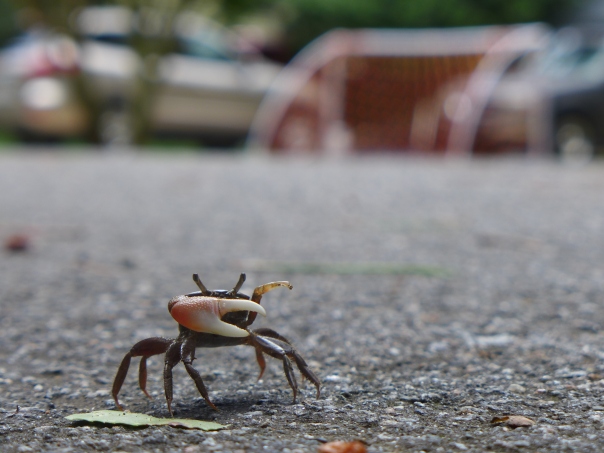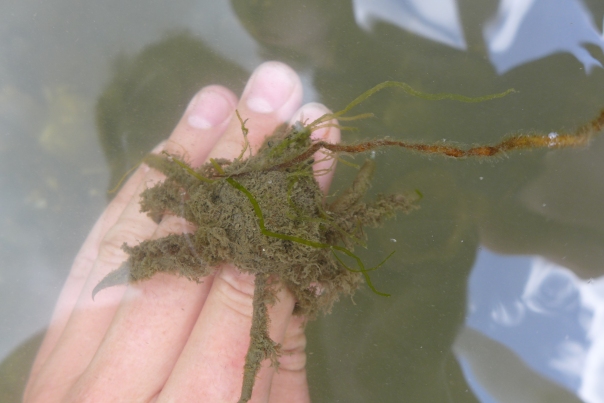Can you see me?

How about now?

Now?

I am a juvenile – and adorable and humble – sand fiddler crab, Uca pugilator. I am tiny and an easy snack, so I look like a grain of sand to keep me out of the belly of a bird.
Can you see me?

How about now?

Now?

I am a juvenile – and adorable and humble – sand fiddler crab, Uca pugilator. I am tiny and an easy snack, so I look like a grain of sand to keep me out of the belly of a bird.
Here is a great video put together by the New York Times explaining how female fiddler crabs not only prefer males with larger claws, but also with claws that wave faster. This is based on work by Australian researchers who used robot claws to wave faster or slower. Waving is part of fiddler-crab courtship. So remember, the next time you’re in a bar or the grocery store and you see someone you’d like to court, wave your little claw off!
Williamsburg, Virginia

I was riding my bike in my neighborhood when I saw a fiddler crab skitter across the blacktop. I stopped immediately to catch it because when it comes to marine life, I’m like a dog who can’t help but chase the rabbit. Plus, I don’t often see marine life skittering across blacktop in the middle of the day in June. I caught it. It was a red-jointed fiddler crab (this post reminds me that I need to write a post about fiddler crabs, but that’s for later).

Fiddler crabs live in burrows in beaches, salt marshes, and mangroves, not roads. But it’s not unusual to see fiddlers on roads that have been built right through the place where they live. In parts of coastal Virginia where the roads cut through the marsh, you can see herds of fiddler crabs roaming the road like cattle. The question is, why do fiddler crabs cross the road? One reason is that the road used to be a marsh where fiddlers grazed. Now they may cross the road for better pastures. Build a road through my house and I’m liable to wander onto it on my way to the kitchen for an avocado. But mind your honking in my house, I have a 2-year-old trying to sleep and an anxious cat who needs therapy.

To-get-to-the-otherside-for-a-snack is a fine answer for why fiddlers cross the road when the road is in their backyard. But the road I found the crab on today was at least 100 feet uphill from the marsh with a forest in between. I found seven wandering fiddlers total. What drives a fiddler to hike through the woods and then onto the highway? Fiddler crabs eat algae and little bits of dead plant found in the soil. I don’t think blacktop or frontyards or woodlands offer much forage for a fiddler.

My working hypothesis is that because we’ve had so much rain that it made the water too fresh for these marine crabs. But that hypothesis was shot down when I found a fine fiddler party in the marsh. My best guess is that because the temperatures were low and the road and forest were damp, they were simply brave crabs exploring new lands. There have been a lot of For Sale signs around. Now might be a good time to move.

In truth, I don’t really know why these crabs traveled so far. As I sit here daydreaming in rain, the why of it leaves my mind, like the crabs, to wander.
P.S. If you enjoy these posts, and of course you do, then please sign up for email updates! I don’t post often. Too much time chasing crabs.



Noank, Connecticut

I’m watching a rock shaggy with algae and mud and debris. I’m watching it eat. I’m watching it move. I’m watching it freeze solid when I slip my hand in the water. I look carefully through the water and pick out 6 more rocks that are not rocks. The cove is littered with rocks, both of ones that eat and ones that don’t. The rocks that eat are decorator crabs. This one is Libinia emarginata.
A decorator crab wouldn’t be get caught dead without wearing the ocean’s latest fashion. Actually, yes it would. Decoration for this crab not about fashion but survival. The more it looks like that rock or that coral or that plant over there the more it can rest easy that it won’t be on someone’s dinner plate. It just can’t help that it looks fabulous. All the time. This is a crab of confidence. One must be confident if it’s your clothes that determine whether you eat or get eaten. How might fashion be shaped if we judged outfits based on whether or not the model got scarfed up by a predator at the end of the runway? A new ‘reality’ show? (I’ll leave it to you to come up with a clever title for this new reality show. Go ahead, whisper you clever little gem to me.)
Decorator crabs are found in variety of habitats including kelps, estuaries, and corals and use whatever’s available to be en vogue. It is a major fashion faux pas to show up to a new event in a new habitat wearing old clothes. A crab placed in a new habitat will shed its old outfit and immediately use local materials to blend in (even an aquarium full of pearls and lace – see video below; called a ‘dresser crab’ by the British). A bit of shaggy algae here, a dab of lace there.
The decorator crab I’ve been watching is also known as a spider crab. All decorator crabs are spider crabs, but not all spiders are decorators. This family brags not only the most fashionable crabs, but also the largest – the 12-foot Japanese spider crab, Macrocheira kaempferi. This crab is not a decorator crab. Perhaps when you’re more leg than body and can stretch up to a second story window (if you’re on your crab tippy toes), then you are either not worried about being someone’s dinner or perhaps you don’t think you’d make a convincing plant.
 Japanese spider crab, Image courtesy of dailymail.co.uk
Japanese spider crab, Image courtesy of dailymail.co.uk